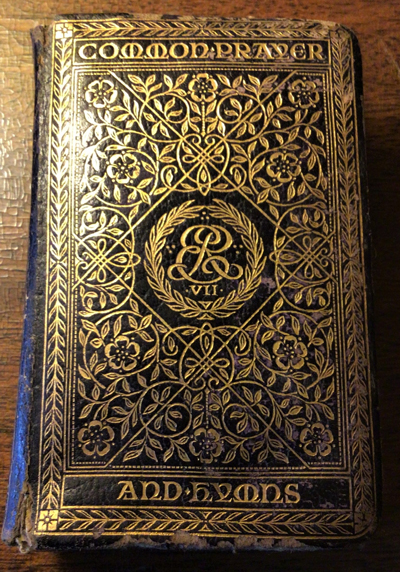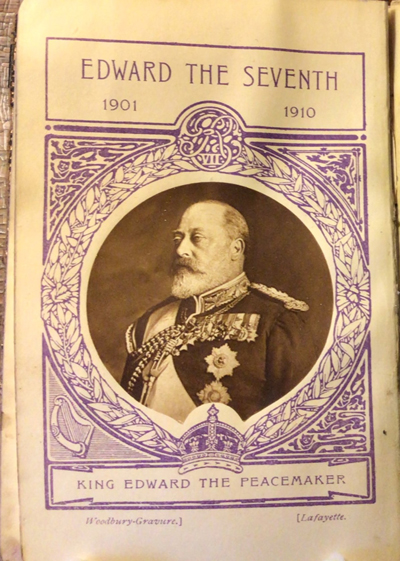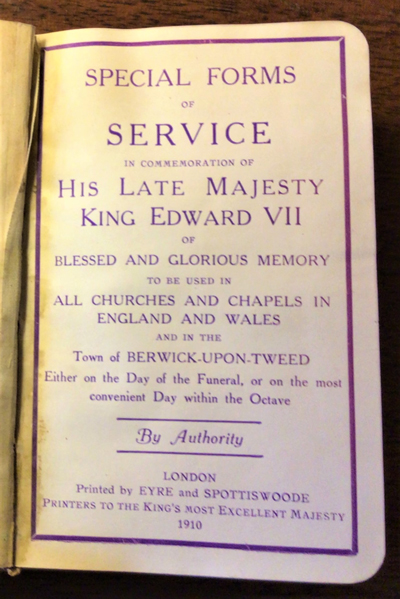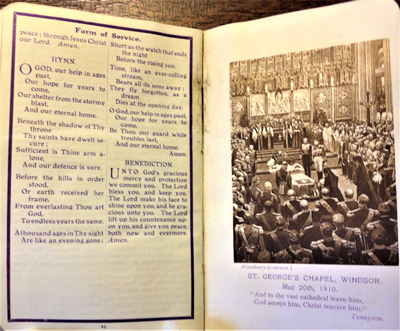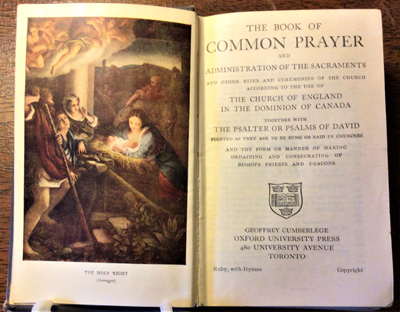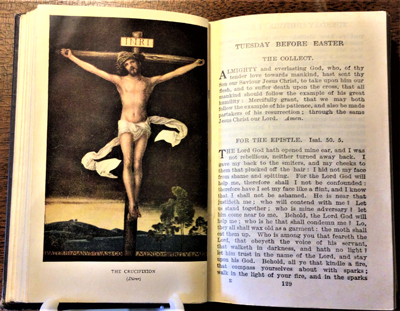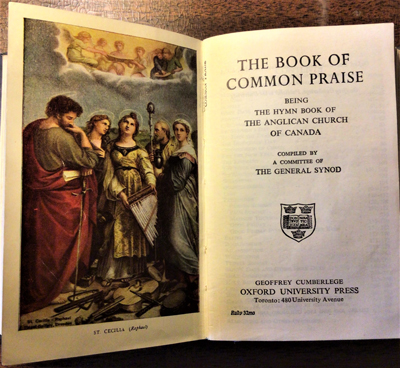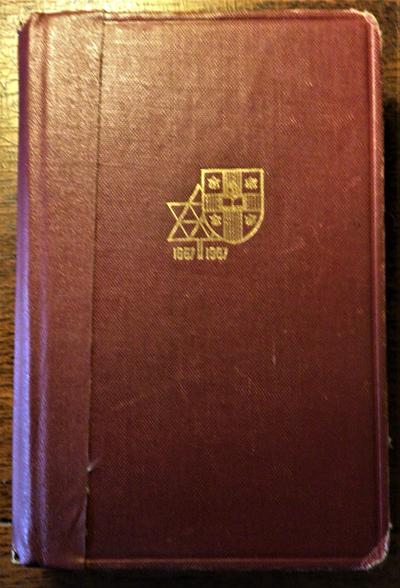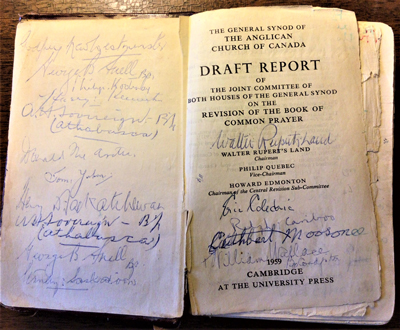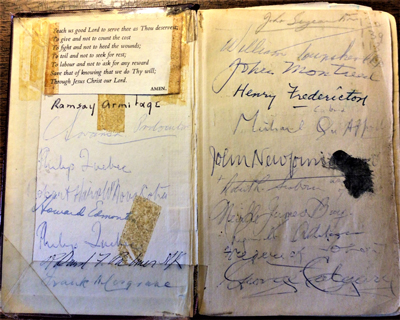Rare and Unique Prayer Books
(By the Revd. Dr. Gordon Maitland, National Chairman of the PBSC.)
As we celebrate the 60th anniversary of the 1962 Canadian Book of Common Prayer in 2022, it would be appropriate to look at some very rare and unique Prayer Books that are a part of our past. In this article I would like to highlight four such books that are a part of my own private collection. The ten photos below will serve to illustrate the remarks that follow.
The first photo shows the cover of a Prayer Book/Hymnal combination that was published by Eyre and Spottiswoode in 1910 as a tribute to the late King Edward VII. It is richly embossed and includes a monogram of the sovereign on the cover; it is slightly smaller than the pew edition 1962 Prayer Book used today. As you can see in photos two through four, reproductions of services used at the King’s lying-in-state and funeral were inserted into the front of the Prayer Book. They were done in purple ink and included photos of the events commemorated. As this book was published shortly after the sovereign’s death, the state prayers in the services still refer to King Edward VII, Queen Alexandra, and George, Prince of Wales. There is another interesting thing about this edition of the BCP. While the BCP itself is the 1662 edition, the hymnal bound with the Prayer Book is the first edition of Common Praise, the hymnal authorized by the Church of England in Canada in 1908. When the Church of England in Canada (as it was then called) became autonomous from the mother Church of England at the first General Synod in 1893, the Canadian Church was free from state control and could publish its own edition of the Prayer Book. However, the newly independent Canadian part of the Anglican Communion chose to produce a common hymnal rather than start on a revision of the Prayer Book. This was due to party strife between the Anglo-Catholic wing of the Church and the Evangelical wing. The former party wanted a more “catholic” edition of the Prayer Book, and the latter party feared that any concession to the high church folks would result in a surrender of Reformation principles. It was thus thought safer to produce a hymnal for the Canadian Church rather than attempt any Prayer Book revision. Since the new hymnal was authorized in 1908 and the King died in 1910, this combination of 1662 BCP and Canadian Common Praise is one of the earliest examples of it. It would appear that the Canadian Church produced such combinations between 1910 and 1922 as a first step towards a truly Canadian liturgical expression of Anglicanism.
The second item that I would like to highlight is a Canadian 1922 Prayer Book/1938 Hymnal published by the Oxford University Press. As can be seen in photo five, the title page refers to “The Church of England in the Dominion of Canada”. The name of our Church was changed to “The Anglican Church of Canada” in 1956. The state prayers in the BCP refer to “Elizabeth our Queen”. Thus, this Prayer Book was published sometime between 1952 and 1956. The remarkable thing about this book is that it is illustrated with more than a dozen reproductions of paintings of the “Old Masters”, as can be seen in photos five through seven. I think it was a nice touch that a painting of St. Cecilia (the patron saint of music) was placed opposite the title page to the Hymnal, as can been seen in photo seven. So far as I know, no other Book of Common Prayer has ever been published by any province of the Anglican Communion as an illustrated book like this one. I have seen BCPs with line drawings or woodcuts, but none (other than this) with reproductions of Renaissance paintings scattered throughout. What was the reason for its publication? Was it meant to commemorate the coronation of Elizabeth II? Or was it a marketing ploy to encourage people to purchase such a book as a gift for confirmations and other special occasions? It does not appear to have had more than one print run, and I have never seen any other copies of it except the one in my possession. Perhaps one day some researcher with a lot of spare time could dig through the archives of the Oxford University Press offices in Toronto to find out more about this edition of the BCP. If any of you reading this article have seen such a BCP yourselves, or possess more information about it, I would very much appreciate hearing from you.
In photo eight is a picture of a standard pew edition 1962 BCP, but in this case it is stamped in gold on the cover with the crest of the Anglican Church of Canada superimposed over the Canadian centennial logo from 1967. The inside cover is marked with an ink stamp, “Saint Paul’s Anglican Church, Windsor, Ontario”. I don’t know whether this commemorative BCP was sold by the Anglican Book Centre to the general public, or if it was a private parish initiative on the part of St. Paul’s Church to celebrate Canada’s centennial. St. Paul’s was closed several decades ago, and the book in the photo was discovered on a shelf outside the chapel of Canterbury College, the Anglican college affiliated with the University of Windsor. Again, if anyone knows anything more about such a BCP I would be very interested in hearing from you.
The last book to be considered here is a recent acquisition sent to me by a long-time member of the Prayer Book Society of Canada, Mr. John Serjeantson of Cowansville, Quebec. It is very much worn from long use, but it is priceless nonetheless. As a young man, Mr. Serjeantson was present at the 1959 General Synod held in Ste. Anne de Bellevue, Quebec, where delegates were to vote on whether to accept the new Book of Common Prayer. Each delegate received a draft copy of the BCP, so that they could see what they were voting on. Mr. Serjeantson took the initiative to go around and have every bishop present (and some others) sign his copy of the draft book. As you can see in photos nine and ten, this is the only copy of the Prayer Book in existence that has the signatures of the bishops who actually voted to approve it on September 3, 1959. I am indebted to Mr. Serjeantson for this unique memorial of Canadian Anglican history.
It is written in the Scriptures, “Of making many books there is no end …“ (Ecclesiastes 12.12). While this is certainly true from an eternal perspective, it is also the case that old books can give us tangible evidence of past events that can be found nowhere else. The rare and unique books presented in this article are a record of both civil and ecclesiastical events that have shaped the history of our Church and nation. It is my hope that they will be seen and enjoyed by generations to come.

